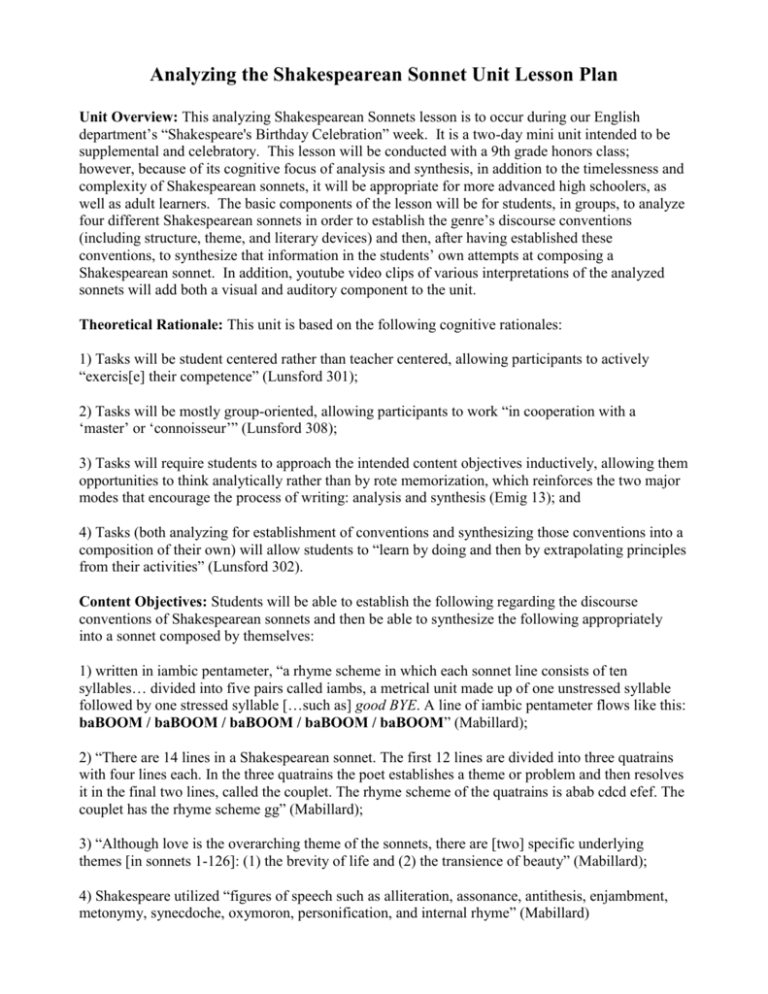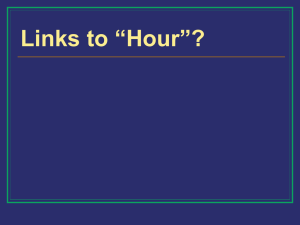Analyzing the Shakespearean Sonnet.doc
advertisement

Analyzing the Shakespearean Sonnet Unit Lesson Plan Unit Overview: This analyzing Shakespearean Sonnets lesson is to occur during our English department’s “Shakespeare's Birthday Celebration” week. It is a two-day mini unit intended to be supplemental and celebratory. This lesson will be conducted with a 9th grade honors class; however, because of its cognitive focus of analysis and synthesis, in addition to the timelessness and complexity of Shakespearean sonnets, it will be appropriate for more advanced high schoolers, as well as adult learners. The basic components of the lesson will be for students, in groups, to analyze four different Shakespearean sonnets in order to establish the genre’s discourse conventions (including structure, theme, and literary devices) and then, after having established these conventions, to synthesize that information in the students’ own attempts at composing a Shakespearean sonnet. In addition, youtube video clips of various interpretations of the analyzed sonnets will add both a visual and auditory component to the unit. Theoretical Rationale: This unit is based on the following cognitive rationales: 1) Tasks will be student centered rather than teacher centered, allowing participants to actively “exercis[e] their competence” (Lunsford 301); 2) Tasks will be mostly group-oriented, allowing participants to work “in cooperation with a ‘master’ or ‘connoisseur’” (Lunsford 308); 3) Tasks will require students to approach the intended content objectives inductively, allowing them opportunities to think analytically rather than by rote memorization, which reinforces the two major modes that encourage the process of writing: analysis and synthesis (Emig 13); and 4) Tasks (both analyzing for establishment of conventions and synthesizing those conventions into a composition of their own) will allow students to “learn by doing and then by extrapolating principles from their activities” (Lunsford 302). Content Objectives: Students will be able to establish the following regarding the discourse conventions of Shakespearean sonnets and then be able to synthesize the following appropriately into a sonnet composed by themselves: 1) written in iambic pentameter, “a rhyme scheme in which each sonnet line consists of ten syllables… divided into five pairs called iambs, a metrical unit made up of one unstressed syllable followed by one stressed syllable […such as] good BYE. A line of iambic pentameter flows like this: baBOOM / baBOOM / baBOOM / baBOOM / baBOOM” (Mabillard); 2) “There are 14 lines in a Shakespearean sonnet. The first 12 lines are divided into three quatrains with four lines each. In the three quatrains the poet establishes a theme or problem and then resolves it in the final two lines, called the couplet. The rhyme scheme of the quatrains is abab cdcd efef. The couplet has the rhyme scheme gg” (Mabillard); 3) “Although love is the overarching theme of the sonnets, there are [two] specific underlying themes [in sonnets 1-126]: (1) the brevity of life and (2) the transience of beauty” (Mabillard); 4) Shakespeare utilized “figures of speech such as alliteration, assonance, antithesis, enjambment, metonymy, synecdoche, oxymoron, personification, and internal rhyme” (Mabillard) Language Objectives: Students will establish and apply the following vocabulary and language skills: 1) Communicate (both aurally and orally) with peers in generation of ideas in order to both comprehend and perform content objectives; 2) Compose a Shakespearean sonnet according to proper discourse conventions; 3) couplet, two lines of verse joined by rhyme; 4) iamb, metrical unit made up of one unstressed syllable followed by one stressed syllable (i.e. baBOOM); 5) iambic pentameter, a rhyme scheme in which each sonnet line consists of ten syllables, divided into five pairs called iambs or iambic feet; 6) pentameter, a line of verse consisting of five metrical feet; 7) quatrain, a stanza of four lines; and 8) sonnet, 14 lines in a Shakespearean sonnet, the first 12 of which are divided into three quatrains with four lines each (with a rhyme scheme of abab cdcd efef), which establish a theme or problem, with the final two lines (a couplet) resolving the problem; and 9) engage both visually and aurally with youtube video clips of various sonnet performances in order to both enjoy and comprehend the genre’s structur Resources/Works Cited: Emig, Janet. “Writing as a Mode of Learning.” Cross-Talk in Comp Theory: a Reader. 2nd ed. Ed. Victor Villanueva. Urbana, IL: NCTE, 2003. Print. 7-15. Lunsford, Andrea A. “Cognitive Development and the Basic Writer.” Cross-Talk in Comp Theory: a Reader. 2nd ed. Ed. Victor Villanueva. Urbana, IL: NCTE, 2003. Print. 299-310. Mabillard, Amanda. “Shakespeare’s Sonnets.” Shakespeare-Online.com. Amanda Mabillard, 2 Mar. 2010. Web. 15 Apr. 2010. Sonnet 18: http://www.youtube.com/watch?v=S8Osse7w9fs Sonnet 29: http://www.youtube.com/watch?v=X6FFtq5CEoM Sonnet 73: http://www.youtube.com/watch?v=7f6R3nZblaA Sonnet 116: http://www.youtube.com/watch?v=l2dJBSfm1P4 Analyzing the Shakespearean Sonnet For each of the following analytical tasks below, please show evidence of your analytical skills in action by documenting in writing your group discussions, categorizations, generalizations, and notes. 1. All but three of Shakespeare’s 154 sonnets are written with the same structure. Analyze the four sonnets below and determine in what structure a Shakespearean Sonnet is formed. (Elements to consider: lines, rhyme patterns, syllables, stress/emphasis patterns, content, concepts, organization of each of these elements, voice, etc.). 2. Sonnets 1-126 are addressed to a young male with whom a powerfully romantic relationship exists. Analyze the four sonnets below and determine what themes are common in these Shakespearean sonnets. 3. Looking through a new criticism lens, analyze the four sonnets below and determine if Shakespeare relied on the use of literary devices (such as alliteration, assonance, personification, etc.) to develop meaning in his sonnets. 4. After analyzing four Shakespearean sonnets, you should now have determined the conventions associated with a Shakespearean sonnet – or in other words, the “rules” necessary to compose your very own Shakespearean sonnet. Synthesize this information and step into the role of Shakespeare by trying your hand at composing a Shakespearean sonnet of your own. SONNET 18 SONNET 29 Shall I compare thee to a summer's day? When, in disgrace with fortune and men's eyes, Thou art more lovely and more temperate: I all alone beweep my outcast state Rough winds do shake the darling buds of May, And trouble deaf heaven with my bootless cries And summer's lease hath all too short a date: And look upon myself and curse my fate, Sometime too hot the eye of heaven shines, Wishing me like to one more rich in hope, And often is his gold complexion dimm'd; Featured like him, like him with friends possess'd, And every fair from fair sometime declines, Desiring this man's art and that man's scope, By chance or nature's changing course untrimm'd; With what I most enjoy contented least; But thy eternal summer shall not fade Yet in these thoughts myself almost despising, Nor lose possession of that fair thou owest; Haply I think on thee, and then my state, Nor shall Death brag thou wander'st in his shade, Like to the lark at break of day arising When in eternal lines to time thou growest: From sullen earth, sings hymns at heaven's gate; So long as men can breathe or eyes can see, For thy sweet love remember'd such wealth brings So long lives this and this gives life to thee. That then I scorn to change my state with kings. SONNET 116 SONNET 73 Let me not to the marriage of true minds That time of year thou mayst in me behold Admit impediments. Love is not love When yellow leaves, or none, or few, do hang Which alters when it alteration finds, Upon those boughs which shake against the cold, Or bends with the remover to remove: Bare ruin'd choirs, where late the sweet birds sang. O no! it is an ever-fixed mark In me thou seest the twilight of such day That looks on tempests and is never shaken; As after sunset fadeth in the west, It is the star to every wandering bark, Which by and by black night doth take away, Whose worth's unknown, although his height be taken. Death's second self, that seals up all in rest. In me thou see'st the glowing of such fire Love's not Time's fool, though rosy lips and cheeks Within his bending sickle's compass come: That on the ashes of his youth doth lie, Love alters not with his brief hours and weeks, As the death-bed whereon it must expire But bears it out even to the edge of doom. Consumed with that which it was nourish'd by. If this be error and upon me proved, This thou perceiv’st, which makes thy love more strong, I never writ, nor no man ever loved. To love that well which thou must leave ere long.








